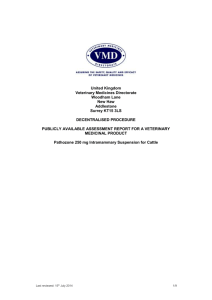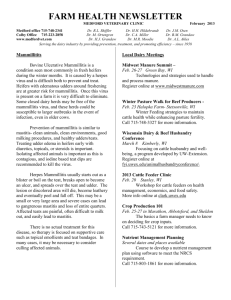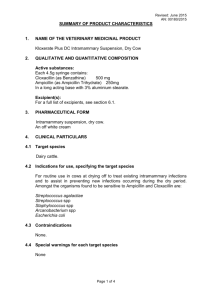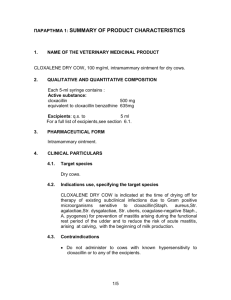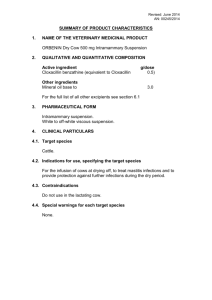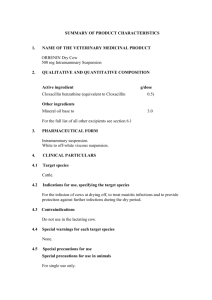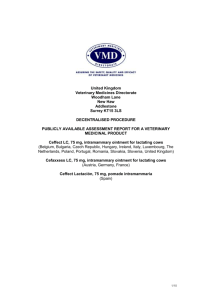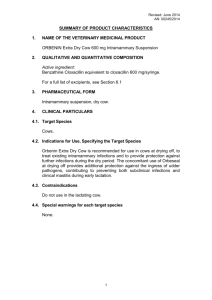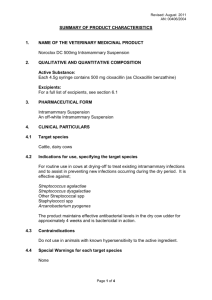United Kingdom Veterinary Medicines Directorate Woodham Lane
advertisement
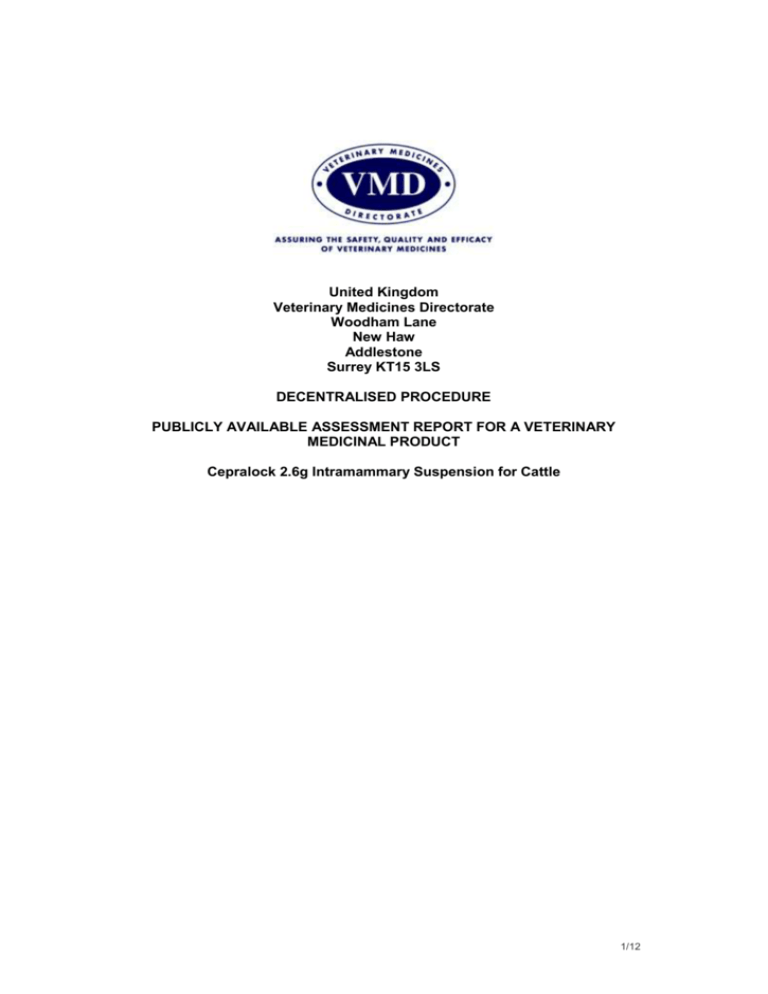
United Kingdom Veterinary Medicines Directorate Woodham Lane New Haw Addlestone Surrey KT15 3LS DECENTRALISED PROCEDURE PUBLICLY AVAILABLE ASSESSMENT REPORT FOR A VETERINARY MEDICINAL PRODUCT Cepralock 2.6g Intramammary Suspension for Cattle 1/12 Cepralock 2.6g Intramammary Suspension for Cattle Norbrook Laboratories Limited UK/V/0474/001/DC Application for Decentralised Procedure Publicly Available Assessment Report MODULE 1 PRODUCT SUMMARY EU Procedure number UK/V/0474/001/DC Name, strength and pharmaceutical form Cepralock 2.6 g Intramammary Suspension for Cattle Applicant Norbrook Laboratories Limited Station Works Camlough Road Newry Co. Down BT35 6JP Active substance(s) Bismuth subnitrate ATC Vetcode QG52X Target species Cattle (dairy cows) Prevention of ascending intramammary infections throughout the dry period. Indication for use In cows considered likely to be free of subclinical mastitis, the product may be suitable for use on its own in dry cow management for mastitis control. Selection of cows for treatment with the product should be based on veterinary clinical judgement. Selection criteria may be based on the mastitis and cell count history of individual cows, or recognised tests for the detection of sub-clinical mastitis or bacteriological sampling. VMD/L4/GAT/016/C 2/12 Cepralock 2.6g Intramammary Suspension for Cattle Norbrook Laboratories Limited UK/V/0474/001/DC Application for Decentralised Procedure Publicly Available Assessment Report MODULE 2 The Summary of Product Characteristics (SPC) for this product is available on the Heads of Medicines Agencies (veterinary) (HMA(v)) website (www.hma.eu). VMD/L4/GAT/016/C 3/12 Cepralock 2.6g Intramammary Suspension for Cattle Norbrook Laboratories Limited UK/V/0474/001/DC Application for Decentralised Procedure Publicly Available Assessment Report MODULE 3 PUBLIC ASSESSMENT REPORT Legal basis of original application Generic hybrid application in accordance with Article 13 (3) of Directive 2001/82/EC as amended. Date of completion of the original decentralised procedure 5th August 2013 Date product first authorised in the Reference Member State (MRP only) Not applicable. Concerned Member States for Austria, Belgium, Czech Republic, Denmark, original procedure France, Germany, Hungary, Ireland, Italy, Netherlands, Poland, Portugal, Slovakia, Spain, Sweden I. SCIENTIFIC OVERVIEW Cepralock 2.6 g Intrammary Suspension for Cattle has been developed as a generic of Orbeseal Dry Cow Intramammary Suspension. The product is for use in dairy cattle and is indicated for the prevention of ascending intramammary infections during the dry period. The product is administered by infusing the content of a syringe into each udder quarter and should be administered immediately after the last milking of the lactation period. The product is contraindicated in cows with clinical or sub-clinical mastitis at drying off and should not be used during lactation. The product is produced and controlled using validated methods and tests which ensure the consistency of the product released on the market. It has been shown that the product can be safely used in the target species. The product is safe for the user, the consumer of foodstuffs from treated animals and for the environment, when used as recommended. Suitable warnings and precautions are indicated in the SPC1. The efficacy of the product was demonstrated according to the claims made in the SPC. The overall benefit/risk analysis is in favour of granting a marketing authorisation. 1 SPC – Summary of product characteristics VMD/L4/GAT/016/C 4/12 Cepralock 2.6g Intramammary Suspension for Cattle Norbrook Laboratories Limited II. QUALITY ASPECTS A. Composition UK/V/0474/001/DC Application for Decentralised Procedure Publicly Available Assessment Report The product contains the active substance bismuth subnitrate, heavy and excipients aluminium stearate, liquid paraffin and povidone, iodinated. The container/closure system consists of a low density polyethylene syringe which has a smooth tapered hermetically sealed nozzle. The product is packaged in boxes of 24 or 60 syringes or alternatively a bucket containing 120 syringes; each syringe contains 4.0 g of product. The particulars of the containers and controls performed are provided and conform to the regulation. The choice of the formulation is justified. The product is an established pharmaceutical form and its development is adequately described in accordance with the relevant European guidelines. B. Method of Preparation of the Product The product is manufactured fully in accordance with the principles of good manufacturing practice from a licensed manufacturing site. Process validation data on the product have been presented in accordance with the relevant European guidelines. The product is manufactured by mixing the aluminium stearate with heated liquid paraffin until the aluminium stearate is fully dissolved. The solution is then cooled and mixed to form a smooth gel to which the bismuth subnitrate is added and mixed. Finally the iodinated povidone is added and thoroughly mixed to create the product which is filled into the syringes and sterilised. C. Control of Starting Materials The active substance is bismuth subnitrate, heavy, an established active substance described in the European Pharmacopoeia (Ph. Eur). An in housespecification was provided, which is in accordance with the European monograph. Details of the manufacture of the active substance have been provided, which is manufactured in accordance with the principles of good manufacturing practice. The active substance specification is considered adequate to control the quality of the material. Batch analytical data demonstrating compliance with this specification have been provided. All excipients comply with their respective Ph. Eur monographs. Testing is performed on receipt and certificates of analysis for each excipient were received from the finished product manufacturer. VMD/L4/GAT/016/C 5/12 Cepralock 2.6g Intramammary Suspension for Cattle Norbrook Laboratories Limited D. UK/V/0474/001/DC Application for Decentralised Procedure Publicly Available Assessment Report Specific Measures concerning the Prevention of the Transmission of Animal Spongiform Encephalopathies There are no substances within the scope of the TSE Guideline present or used in the manufacture of this product. E. Control on intermediate products Not applicable. F. Control Tests on the Finished Product The finished product specification controls the relevant parameters for the pharmaceutical form. The tests in the specification, and their limits, have been justified and are considered appropriate to adequately control the quality of the product. The tests include identification and assay of the active substance, viscosity, appearance, seal integrity and particle size. Satisfactory validation data for the analytical methods have been provided. Batch analytical data from the proposed production site have been provided demonstrating compliance with the specification. G. Stability Stability data on the active substance have been provided in accordance with applicable European guidelines, demonstrating the stability of the active substance when stored under the approved conditions. A retest period of 4 years has been established for the active substance. Stability data on the finished product have been provided in accordance with applicable European guidelines, demonstrating the stability of the product throughout its shelf life when stored under the approved conditions. Stability data have been provided for three batches of product stored at 25ºC/60%RH for up to 36 months, 30ºC/65%RH for up to 12 months and 40ºC/75%RH for up to 6 months. A shelf of 3 years is supported for the finished product. H. Genetically Modified Organisms Not applicable. J. Other Information The shelf life of the finished product as packaged for sale is 3 years. VMD/L4/GAT/016/C 6/12 Cepralock 2.6g Intramammary Suspension for Cattle Norbrook Laboratories Limited III. SAFETY AND RESIDUES TOXICOLOGICAL) III.A Safety Testing UK/V/0474/001/DC Application for Decentralised Procedure Publicly Available Assessment Report ASSESSMENT (PHARMACO- Pharmacological Studies As this is a generic application submitted according to Article 13 (3) of Directive 2001/82/EC as amended and bioequivalence with the reference can be assumed because of the nature of the product, results of pharmacological studies are not required. Pharmacodynamics The applicant has provided data that indicates the active substance has no pharmacological activity per se. The product is infused into each udder quarter and acts as a physical barrier to prevent bacteria entering the teat canal and thus reduce the incidence of ascending intramammary infections during the drying off period. Pharmacokinetics The data indicate the active substance, bismuth subnitrate, is not absorbed systemically (<1%) from the intramammary gland, the product forms a seal in the teat until it is physically removed. Any negligible amounts of bismuth subnitrate that are absorbed are not metabolised and are excreted via the urine and faeces. Toxicological Studies As this is a generic application submitted according to Article 13 (3) of Directive 2001/82/EC as amended and bioequivalence with the reference can be assumed because of the nature of the product, results of toxicological studies are not required. Observations in Humans The active substance, bismuth subnitrate, has been used in human medicine to treat gasto-intestinal (GI) disturbances, skin lesions and syphilis. Side effect have been reported, including GI disturbances, nephrotoxicity, encephalopathy and hepatotoxicity, but these only occur following chronic oral exposure or high intramuscular doses. User Safety The applicant has provided a user safety assessment in compliance with the relevant guideline which shows that as the product is supplied in a ready to use form risk of exposure is minimal. However the possible routes of exposure have been identified as spillage onto skin, accidental ingestion and accidental eye contact. VMD/L4/GAT/016/C 7/12 Cepralock 2.6g Intramammary Suspension for Cattle Norbrook Laboratories Limited UK/V/0474/001/DC Application for Decentralised Procedure Publicly Available Assessment Report Warnings and precautions as listed on the product literature are adequate to ensure safety to users of the product: Avoid contact with skin or eyes. Should skin or eye contact occur, wash the affected area thoroughly with water. If irritation persists, seek medical advice and show this label to the doctor. If you know that you are allergic to bismuth salts, avoid using this product. Wash hands after use. Ecotoxicity The applicant provided a Phase I environmental risk assessment in compliance with the relevant guideline which showed that no further assessment is required. The assessment concluded that the product would be administered to most of the herd in the same year, however a PECsoil initial was calculated to be less than 100µg/kg indicating the product is unlikely to pose a risk to the environment. Warnings and precautions as listed on the product literature are adequate to ensure safety to the environment when the product is used as directed. III.B Residues documentation Residue Studies No residue depletion studies were provided for this application. The active substance and excipients included in the product have been considered by the European Medicines Agency (EMA) to be appropriate for use in food producing species. No further assessment was required. Withdrawal Periods Meat and offal: Zero days Milk: Zero hours IV CLINICAL ASSESSMENT (EFFICACY) IV.A Pre-Clinical Studies Pharmacology Pharmacodynamics The applicant has provided data that indicates the active substance has no pharmacological activity per se. The product is infused into each udder quarter and acts as a physical barrier to prevent bacteria entering the teat canal and thus reduce the incidence of ascending intramammary infections during the drying off period. Teat sealants offer an alternative to the prophylactic use of antimicrobials during the dry period. VMD/L4/GAT/016/C 8/12 Cepralock 2.6g Intramammary Suspension for Cattle Norbrook Laboratories Limited UK/V/0474/001/DC Application for Decentralised Procedure Publicly Available Assessment Report Pharmacokinetics The data indicate the active substance, bismuth subnitrate, is not absorbed systemically (<1%) from the intramammary gland, the product forms a seal in the teat until it is physically removed. Any negligible amounts of bismuth subnitrate that are absorbed are not metabolised and are excreted via the urine and faeces. As the active substance, bismuth subnitrate, is not systemically absorbed bioequivalence cannot be demonstrated between Noroseal and the reference product. Tolerance in the Target Species of Animals The applicant has conducted a target animal tolerance study. The product was used in four lactating dairy cows to examine the irritancy of the product. One syringe of the product per quarter was administered by intramammary infusion on one occasion. The teat seal was removed 14 hours after administration. The udders of the cattle were examined at 14 hours post-administration and again several times until 121 hours after treatment for clinical signs such as pain, swelling, discolouration, hardness and other signs of adverse reaction. Milk sampling was performed pre- and post-treatment and milk yield was also measured. No adverse effects were seen following treatment and whilst there was a slight variation in milk yield it was not significant. The product has been shown to cause minimal irritancy in the target species. The product literature contains suitable warnings and precautions for use in the target species. IV.B Clinical Studies Bioequivalence of the test product and the reference product cannot be demonstrated as neither formulation is absorbed systemically. The applicant has submitted studies to compare the clinical equivalence and the persistence of the test product compared to the reference product. An in vitro study was also provided to investigate the anti-infective properties of the excipient PVP-iodine. Study title Objectives Test site(s) Compliance with Regulatory guidelines Test Product VMD/L4/GAT/016/C A comparative study to investigate the clinical equivalence of Cepralock teat seal to Orbeseal during the dry period. The aim of the study was to assess the ability of the test product to prevent intramammary infection during the dry period by comparison with the reference product. Multi-centre, commercial farms in the UK. Good Clinical Practice (GCP) The test product containing, bismuth subnitrate was 9/12 Cepralock 2.6g Intramammary Suspension for Cattle Norbrook Laboratories Limited Control product/placebo Animals Outcomes/endpoints Randomisation Blinding Method Statistical method RESULTS Outcomes for endpoints DISCUSSION VMD/L4/GAT/016/C UK/V/0474/001/DC Application for Decentralised Procedure Publicly Available Assessment Report administered via infusion into the teat canal at drying off. Use was combined with an intramammary antimicrobial. A positive control was used. The reference product, containing bismuth subnitrate, was also administered via infusion into the teat canal at drying off. Use was combined with an intramammary antimicrobial Healthy dairy cows over 2 years old with four functional udder quarters were used in the study. The animals were not to have received anti-infectious or antiinflammatory treatments for 30 days prior to the study. Milk was sampled for somatic cell counts and bacteriology. Randomised. Single blind. Cows were randomly assigned to either a test group or control group and their udders were examined for abnormalities on Day -7, Day 0 and within 2 days post calving. Milk sampling for somatic cell counts (SCC) took place on Day -7 and Day 6-9. Bacteriology was performed on milk samples taken on Day -7, Day-6 and again on Day 2, the presence of a pathogen of interest was classed as a positive outcome. Bacteriology results were compared using Chi-square test for equivalence and SAS system software was used to determine the 95% confidence intervals. SCC results were compared using Student’s t-test. Bacteriology pre- and post-treatment was compared for the test and reference product. Each udder quarter was compared, 1036 quarters were negative post-treatment and 39 positive for the test product whilst 1043 were negative for the reference product and 25 positive posttreatment. Chi-squared analysis found a p = 0.2039 (limit p = 0.05) thus indicating equivalence of the two products. The SCCs of animals receiving the test product and animals receiving the reference product were compared at the beginning and end of the study. A significant difference was seen between the groups at the start of the study (p = 0.0355) with the test product being more challenged. Following treatment the p value = 0.4223, indicating equivalence of the two products. The study supports a conclusion that the test and reference products are clinically equivalent at providing a physical barrier to prevent new intramammary infections. 10/12 Cepralock 2.6g Intramammary Suspension for Cattle Norbrook Laboratories Limited UK/V/0474/001/DC Application for Decentralised Procedure Publicly Available Assessment Report A study to compare the persistence of the test product to the reference product was also performed. Both the test and reference product were administered to thirty dairy cows via infusion into the teat canal. The test product was administered to the left front and right rear udder quarters, whilst the reference product was administered to the right front and left rear udder quarters. The teats were stripped of the sealants after 35 days. The proportion of infused teat sealant recovered was compared for the products. This was determined by estimating the weight of teat sealant infused and weighing the amount of teat sealant recovered. The SCC was also measured and compared. Analysis of equivalence performed on the proportion of teat sealant recovered resulted in a p value = 0.08, indicating no difference in the proportion based on product type. The SCC results also indicated no difference, when comparing the geometric means on a log scale (p = 0.21), between the two products. The applicant concluded there is no difference in the persistence of the test product and the reference product. The final in vitro study submitted by the applicant aimed to investigate the efficacy of the test product in preventing infection by three mastitis pathogens; Escherichia coli, Streptococcus uberis and Streptococcus dysgalactiae. The pathogens were isolated and all were of bovine origin. Firstly a broth microdilution method was employed. The MICs2 were determined for the pathogens and were all ≤4 mg/ml. A well-diffusion based assay was also performed. Zones of clearing were measured for each of the pathogens; E.coli 14-25 mm, S.uberis 10-15 mm and S.dysgalactiae 12-14 mm. The study demonstrated anti-infective effects of PVP-iodine in vitro. However, an indication for anti-infective properties cannot be supported on the basis of this trial alone. V OVERALL CONCLUSION AND BENEFIT– RISK ASSESSMENT The data submitted in the dossier demonstrate that when the product is used in accordance with the Summary of Product Characteristics, the benefit/risk profile for the target species is favourable and the quality and safety of the product for humans and the environment is acceptable. 2 MIC – Minimum inhibitory concentration VMD/L4/GAT/016/C 11/12 Cepralock 2.6g Intramammary Suspension for Cattle Norbrook Laboratories Limited UK/V/0474/001/DC Application for Decentralised Procedure Publicly Available Assessment Report MODULE 4 POST-AUTHORISATION ASSESSMENTS The SPC and package leaflet may be updated to include new information on the quality, safety and efficacy of the veterinary medicinal product. The current SPC is available on the Product Information Database of the Veterinary Medicines Directorate website. (www.gov.uk/check-animal-medicine-licensed) The post-authorisation assessment (PAA) contains information on significant changes which have been made after the original procedure which are important for the quality, safety or efficacy of the product. The PAA for this product is available on the Product Information Database of the Veterinary Medicines Directorate website. (www.gov.uk/check-animal-medicine-licensed) VMD/L4/GAT/016/C 12/12
